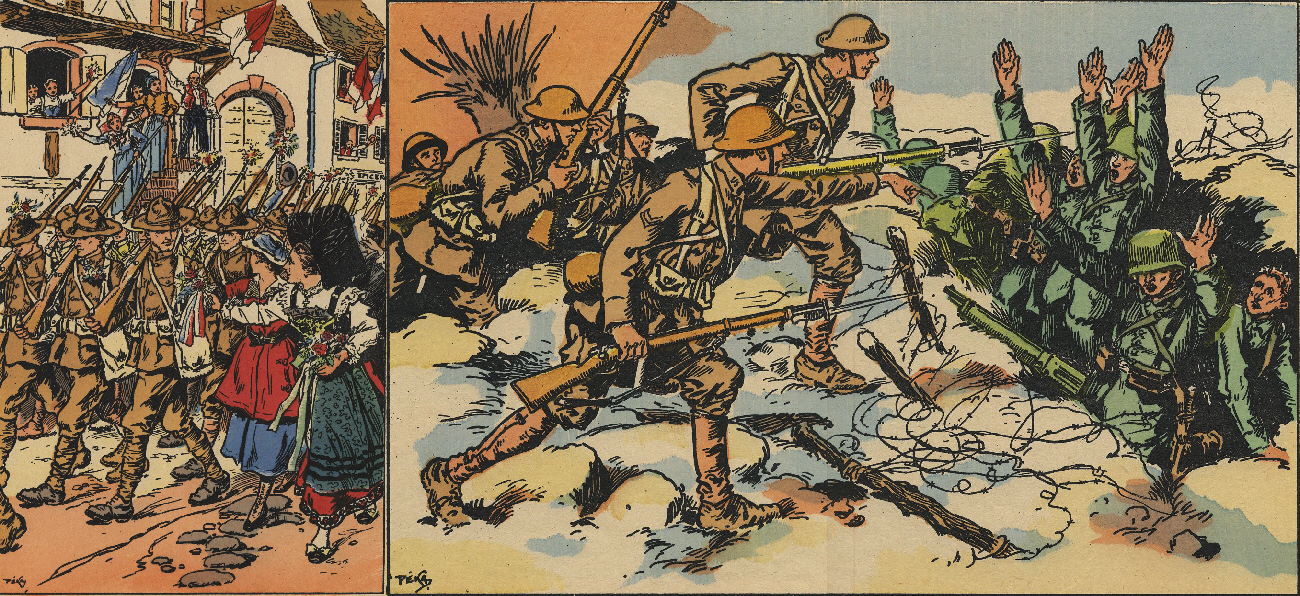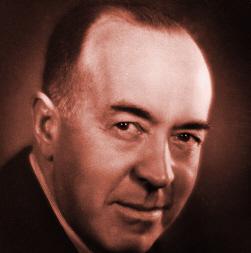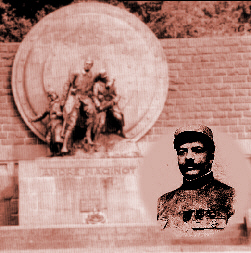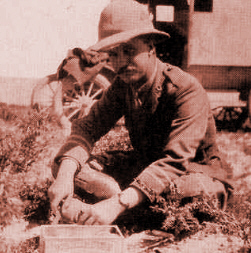


January 1913
Death of Von Schlieffen
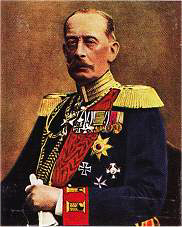
Graf von Schlieffen
|
Alfred, Graf von Schlieffen, (born 28 February 1833, Berlin—died 4 January 1913, Berlin), was the head of the German General Staff who developed the plan of attack (Schlieffen Plan) that the German armies used, with significant modifications, at the outbreak of World War I. The famous plan assumed a two-front war against Russia and France, with an early concentration against France to achieve a quick victory in the west before focusing maximum German resources on the larger opponent, Russia.
The plan was finalized in Schlieffen's last year in charge of the General Staff 1905. His successor, Helmuth von Moltke, modified it substantially almost immediately after Schlieffen's retirement, and was thus blamed for its failure in 1914. The underlying approach, however, may have been more at fault. Modern commentators have pointed out the troop-exhausting and difficult to supply nature of the long pin-wheeling attack through France, the lack of adequate command, control, and communications technology at the time, and the near-suicidal decision to initiate a two-front war against two formidable powers.
Despite the plan's failure, though, von Schlieffen remained influential during the interwar period. His study of Hannibal's annihilation of a Roman army at Cannae, published in 1909, kept general staffs thinking in terms of bold decisive offensives. Case Yellow, the devastating German victory in the west in 1940, bore his imprint.
|
|
TRENCH REPORT: Big News from Washington!
HOUSE PASSES
THE FRANK BUCKLES WWI
MEMORIAL ACT
WASHINGTON, DC — The House of Representatives unanimously passed H.R. 6364, the bipartisan Frank Buckles WWI Memorial Act. The bill was introduced by Congressman Ted Poe (R-TX) along with Congressman Emanuel Cleaver (D-MO) and Congresswoman Eleanor Holmes Norton (D-DC). This legislation (1) establishes a commission to commemorate the centennial of World War I; (2) re-designates the Liberty Memorial of Kansas City as the "National World War I Museum and Memorial;" and (3) establishes a new, stand-alone World War I Memorial on the National Mall. Before becoming law, of course, the bill still must be passed in the U.S. Senate. MH
News from the World War One Historical Association
Click on Title or Icon to Access
|
How Can I Learn More About the U-boat War?
Visit the WW1HA primer on the submarine and its emergence as a major weapon in the Great War. (link)
2013 Events
The WW1HA New York - New England Branch
2013 Annual Seminar
16 March at the Vassar College Alumnae House in Poughkeepsie, New York. Click here for details: (link)
The League of World War I Aviation Historians Has Announced Their 2013 Seminar
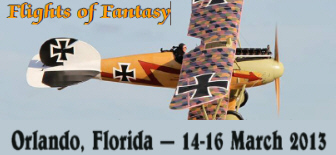 Click on Image to Download Event Flyer
Click on Image to Download Event Flyer
|
|
Winter in the Trenches
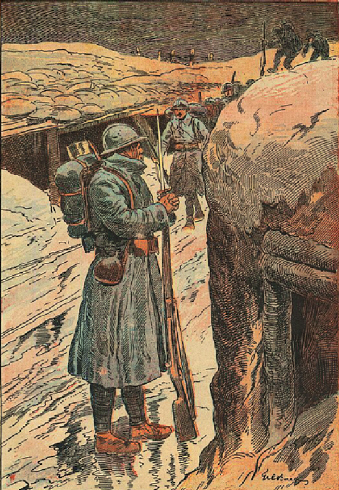
From Almanach de la Depeche,
1918
This Month's Internet Feature
Sir Harry Lauder
The most popular music hall entertainer of the period, Harry Lauder worked tirelessly recruiting and entertaining troops, especially after the death of his son, Capt. John Lauder, who died on the Somme in December 1916
Biography of Harry Lauder, with Two Early Songs
Photo Album of Harry
Download Harry's Memoir A Minstrel in France
Harry's Family Memorial to His Son
YouTube Video Killiecrankie, Your Editor's Favorite from Harry
YouTube Video Keep Right on Till the End of Road, Harry's Inspiring Signature Song Written After the Death of His Son.

U-21 had a remarkable voyage to the Dardanelles area in 1915. Within three days the German submarine, commanded by Kapitänleutnant Otto Hersing, sank two British battleships, HMS Triumph (25 May) and HMS Majestic (27 May).

A mixture of contradictories which never were—perhaps could never have been—harmonised.
John Buchan on T.E. Lawrence
|
|
Page Two
|
|
|

|
|
Mte. Cengio and the Grenadier's Leap
Sardinian Grenadier Memorial
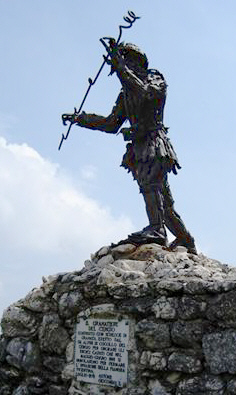
|
In 1916 scenic 4,400-ft.-tall Mte. Cengio, which has breathtaking views of Venice and the Adriatic, was a "back door" to the Asiago Plateau or "Altipiani" and the Italian position that had been stabilized after the spring 1916 "Strafexpedition" of the Austro-Hungarian Army. It would be the scene of ferocious fighting in mid-1916 with attempts to penetrate the Italian defenses from the rear by their opponents. Had the Austrian forces been able to clear the Altipiani and move down on to the Veneto, they would have been in the rear of both Italian Armies on the Isonzo, the major battle sector at the time. Consequently, Mte. Cengio was for a period of the greatest strategic importance.
The summit was defended by the 2nd Regiment of the Sardinian Grenadiers. In June 1916 the Grenadiers found themselves with their ammunition exhausted and engaged in furious hand-to-hand fighting at the edge of a precipice. Exhausted, yet still determined not to surrender, an unknown number of the Grenadiers wrapped their arms around their opponents and jumped, dragging their enemies off the cliff, to their mutual deaths.
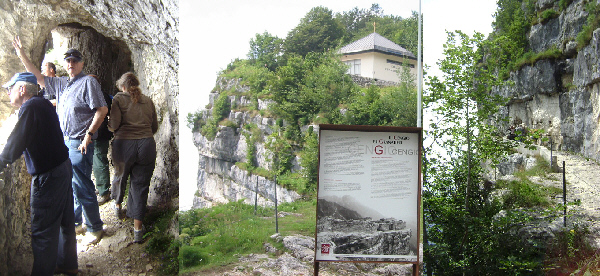
Inside the Galleries - Chapel and Site of the Leaps - Mule Path
Today, the haunting metallic statue above honors the 2,000 Sardinian Grenadiers who perished on the mountain in 1916, some of whom died taking an opponent with them in the "Grenadier Leap." Afterward, sensing it was a weak point in their defensive line, the Italian Command turned it into a major defensive position. A series of galleries were built for artillery and observation posts and mule paths (mulaterria) were constructed to supply them.
|
|
Downton Abbey Returns!
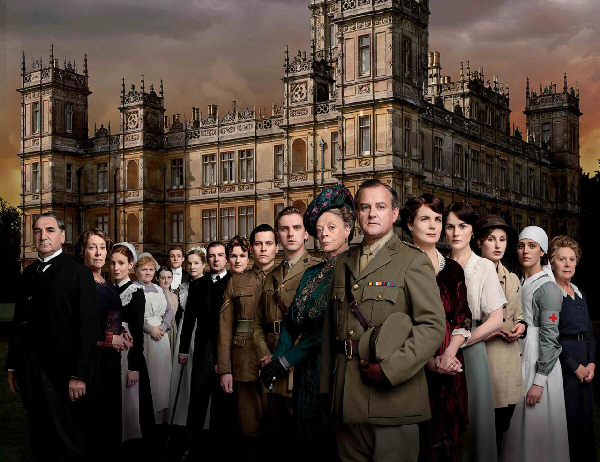
The only competitor ever for the Upstairs Downstairs crown as the all-time most beloved Masterpiece Theatre presentation for the World War One community of fans, Downton Abbey, returns on Sunday 6 January for its third season.
|

Capt. Crawley at the Somme
|
The Great War has ended but its impact is still felt at Downton where Robert, Earl of Grantham, his extended family, and (mostly) loyal staff will face more wrenching social changes, romantic intrigues and personal crises. There will be some changes in the cast from last year, but rest assured the ever-quotable Violet, the Dowager Countess ("Don't be defeatist, dear. It's very middle class."), played by Maggie Smith will be back in full form. Captain Matthew Crawley, however, having survived his serious war wounds and now happily married, has a surprise fate awaiting him.
Our assistant editor, Kimball, wishes me to point out that the single most important subplot during season three will involve the fate of the admirable Mr. Bates, Lord Grantham's former batman from the Boer War and, more recently, his valet, who is serving a life sentence (commuted from hanging) for poisoning his first wife. Needless to say, Kimball is rooting for Bates's freedom.
|
My World War I Expeditions for Valor Tours, Ltd.

Click on Image to Send Email
|
Page Three
|
|
|
|
What Did Houdini Do During the Great War?
|
Another installment of our new feature, "What Did Houdini Do During the Great War?" that focuses on unknown or unlikely participants in the war. (We will need suggested names from the readers to continue this feature.)
Edgar Rice Burroughs (1875-1950)
Author
Edgar Rice Burroughs (1875-1950) had served with the U.S. 7th
Cavalry before the turn of the century. After many adventures
and jobs he began writing at age 35 and hit upon fame with
Tarzan of the Apes, and its many sequels and his other imaginative works. During the First World War Burroughs served as a major with the 1st Battalion, 2d Infantry, Illinois Reserve Militia. Other than recruiting efforts around his home in Oak Park, not much can be found about his activities with the 2nd Infantry at this time. Burroughs, however, managed to make quite a splash by publishing a proposal for a national reserve army in the Army and Navy Journal. The film version of
Tarzan of the Apes, also completed about this time, took a lot of his attention. It was one of the first films to make more than a million dollars for its producers, and Burroughs owned stock in the film. After witnessing the bombing of Pearl Harbor, he became perhaps the oldest war correspondent
covering the bombing of the South Pacific and was an actual participant on at least one bombing mission.
Andre Maginot (1877-1932)
Soldier and Politician
Andre Maginot was a lawyer who chose to pursue a
political career. After his 1910 election to the Chamber of Deputies he
had advanced to the position of under-secretary of war by the
eve of hostilities, but chose to serve in the ranks as an enlisted man.
Stationed near Verdun, he was promoted to sergeant for his
coolness under fire. In November his knee was shattered and
he returned to government. In the interwar period he was a
champion for war veterans and for the series of fortifications
which bear his name. He is honored today with one of the
most impressive monuments on the Verdun battlefield (inset).
Kermit Roosevelt (1889-1943)
Adventurer, Banker, Author, Soldier
Kermit Roosevelt, MC, was a son of U.S. President Theodore Roosevelt. He was an explorer
on two continents with his father, a graduate of Harvard University, a soldier serving in two world wars, with both the British and U.S. Armies, a businessman, and a writer. He fought a lifelong battle with depression and alcoholism, and eventually committed suicide. His son, also named Kermit, was a notable operative in the early days of the CIA.
Impatient for American participation in the First World War, Roosevelt
joined the British Army to fight in Mesopotamia (modern-day
Iraq). He was attached to the 14th Light Armoured Motor
Battery of the Machine Gun Corps, and saw action at Tikrit and
Baghdad. He was later awarded a Military Cross for his British
service and wrote an admired memoir of this period, War in the Garden
of Eden, in the interwar period. When the United States finally
joined the war, Roosevelt was transferred to the AEF in Europe,
relinquishing his British commission to serve as a U.S. field artillery officer. In the Second World War, he similarly served in both nation's armies before his suicide while posted in the Aleutians.
|
World War I Headlines
in the 21st Century
|
|
Europe Still Honors the Doughboys and GIs
One of the pleasures of visiting Europe for an American is meeting people from other lands who appreciate the U.S. contribution in the World Wars, or just love things American. Just as in the States, there are reenactment or "living history" groups that portray American soldiers at ceremonies and anniversary events. The members just happen to be citizens of other nations, but they are proud to stand in for the Yanks.
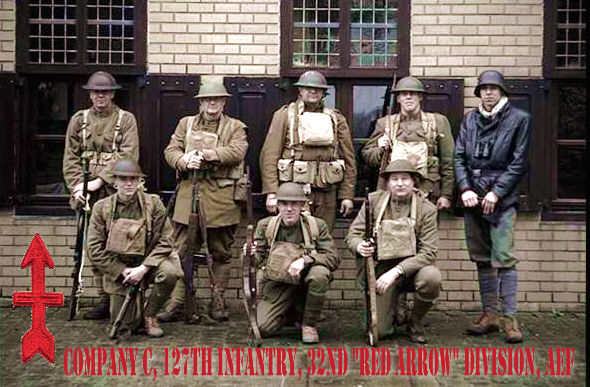
The Dutch U.S. Doughboys
From left: Front row, kneeling - Vincent Saedeleer, Ben de Staercke, Rick van Nooij;
back row, standing - Sebastiaan Timmers, Ad Moest, Edwin van Riemsdijk, Kenneth de Pape, Gert Jan Beukers (German Soldier); MIA, Sidney Hesselberth.
Pictured above in authentic WWI kits are the Dutch U.S. Doughboys, who have participated in ceremonies at the Romagne cemetery and at other Western Front battlefields. They are portraying the members of Company C, 127th Infantry of the Red Arrow Division. The DUDs, as they like to call themselves, maintain a very informative website at: http://www.dutchusdoughboys.nl. In earlier issues of the Trip-Wire, we have mentioned a similar UK organization, Pershing's Doughboys, who also do a great job participating in events on the old battlefields. Their website at http://www.pershingsdoughboys.org.uk/index.html
is also highly informative and contains a bunch of interesting photos.
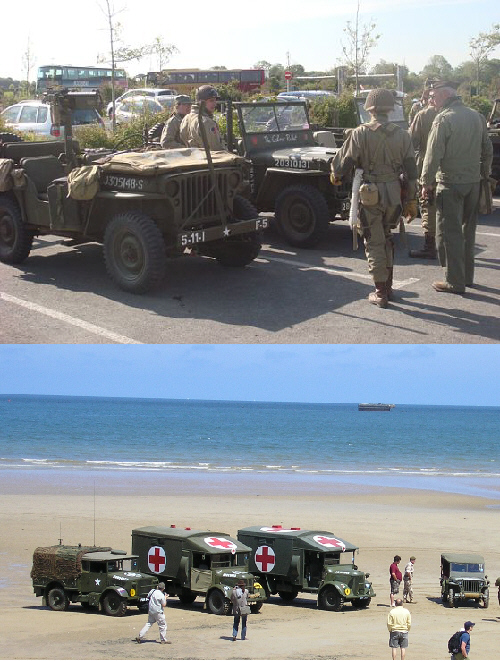
|
An even bigger, loose alliance that has representatives from almost every European country is centered around the preservation of American military vehicles. These informal groups and individuals are almost all focused on World War II, but I have heard rumors of similar collectors of Great War vehicles. An amazing number of them have acquired and restored surplus jeeps, ambulances, and trucks of every type. They assemble on big occasions to display their vehicles and portray GIs, since almost all of them are also collectors of uniforms and memorabilia. So when they gather, they are "in character" as soldiers, MPs, or drivers. However, many of them do not speak English. The photos here are from the 65th Anniversary of the Normandy Invasion in 2009. In the upper photos are MPs and paratroopers at Ste. Mere Eglise, none of whom spoke English, so I'm not sure where they came from. Below is an ambulance company on display at Arromanches. A piece of the Mulberry Harbor is visible in the distance. Despite the language difficulties, everyone in our group felt these preservationists/reenactors made a tremendous contribution to the remembrance of the invasion.
|
|
|
 |
For Your Library
The Best Battlefield Guides
Are from Major and Mrs. Holt
Reviewed by Your Editor
|
The two people pictured on the right are my friends, Tonie and Valmai Holt. I thought the readers of the Trip-Wire should become acquainted with them because they have been leaders in setting the stage for the forthcoming commemorations of the Great War's centennial. T & V will be advisers on many of the ceremonies remembering the events of the war, like the famous Christmas Truce, and the legendary personalities, such as Old Bill and his creator Bruce Bairnsfather, and Rudyard Kipling and his son Jack.
They also happen to publish the very best battlefield guides available on both World Wars. Here we will focus on their books pertaining to the Great War, but I also use their guide to Normandy when I lead tours there. Since the 1970s, when they founded Major and Mrs. Holt's Battlefield Tours, T & V have been in the forefront of the remembrance of the sacrifice made by the veterans of 1914-18 and have become the leading experts on the battlefields of France and Flanders. After selling their travel business they continued publishing what have become simply the "top of the line" battlefield guides and maps. Here is the secret to their quality: they never stop studying the events of 1914-18 and 1939-45, and so they can regularly update each of the guides with more information. These guidebooks and maps have become so comprehensively informative that—if you are unable to travel to Europe yourself—you can use them to treat yourself to "virtual tours" of the battlefields.
Let me use their newest products, T & V's latest updates of their Ypres Salient & Passchendaele guide and map to discuss how they help the battlefield tourist. On their 19x23-inch Salient map, superimposed on an up-to-date road map with the battle lines for all the major operations, are close to a thousand color-coded designators for monuments, memorials, plaques, crossroads, headquarters, bunkers, preserved trenches, mine craters, museums, war cemeteries, and individual grave sites or commemorations of notable persons.
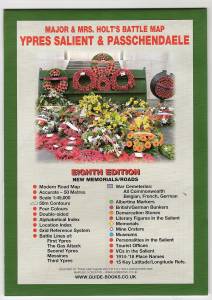
Ypres Map (folded) |

Ypres Guidebook |
By itself, the map could be overwhelming. But, when the visitor combines it with the Holt's coordinated 288-page guidebook to the Salient, he is equipped to locate every feature of the Ypres battlefields quickly. T & V understand that most visitors have only a day or two to visit and have designed a system for maximizing content in a short period of time. The guide features two approach routes to the town and three in-Salient itineraries. Itinerary One, for example, begins and ends in Ypres proper, covers 36.8 miles and includes among its several dozen destinations, a walking tour of Ypres proper, Vancouver Corner, Tyne Cot Cemetery, Passchendaele, Gheluvelt Chateau, Polygon Wood, Hooge Crater, Hill 60, Hellfire Corner (now a traffic circle), and the Menin Gate. But the guide is not just for navigation; on its pages are photos and detailed historical information on every stop on the itinerary.
What I've described thus far sounds like the perfect set of tools for the first time visitor. However, any student of the war can benefit from these works. I am not a first time visitor to the Salient—I've been traveling there since 1990—and I have been astonished after reading T & V's latest update about how much I've missed in the Ypres Salient over the years. Not only did I not know that famed author Erich Maria Remarque served at Ypres, but I also learned that he did so at a major landmark I'd never heard of called the "Death Mill." Nor was I aware that the story I've been telling my groups about the origins of the name "Tyne Cot" (supposedly due to the resemblance of some German bunkers at the site to Tyneside cottages) had been superseded by new research (nearby trenches were named after rivers including the Tyne). Nor did I previously succeed in finding Scott's Bunker at Polygon Wood (got lost the last time I tried), but I'm going to try next time following the Holts' directions. I won't continue on with this list, which could be very long, but the point is that there is a world of knowlege to be gained in all of the T & V's guides for even experienced readers and travelers.
As I said, the Holt's guides are the very best. You can order all of them with the accompanying maps at their website http://www.guide-books.co.uk/. These are essential additions to the library of every student of the Great War.
|
|
| |
|



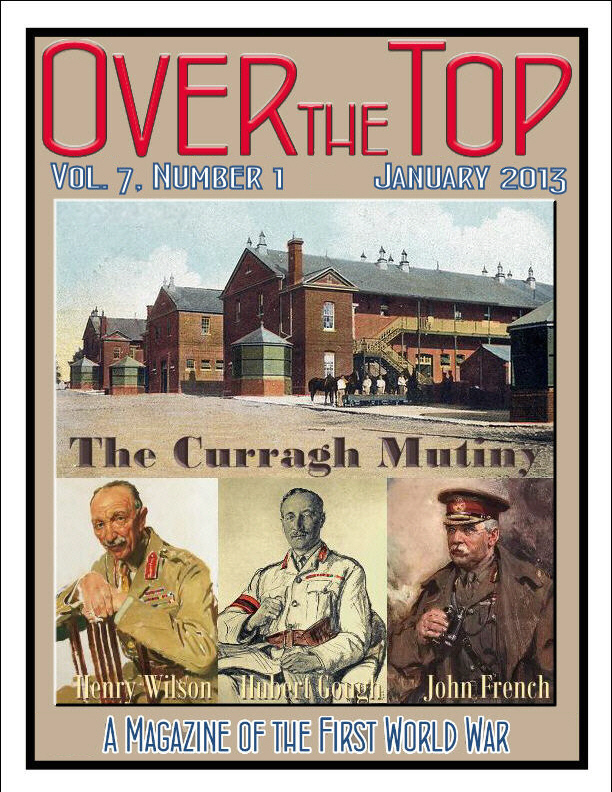
 Click on Image to Download Event Flyer
Click on Image to Download Event Flyer




